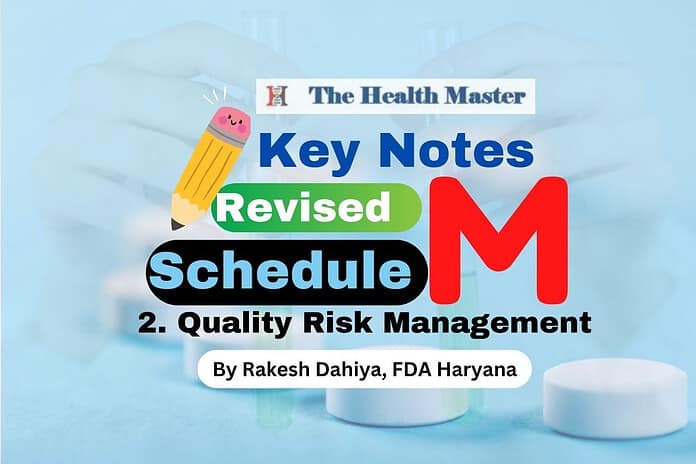- Key Notes on Revised Schedule M: API Part-3 - April 7, 2025
- Key Notes on Revised Schedule M: API Part-2 - March 28, 2025
- Key Notes on Revised Schedule M: API Part-1 - March 15, 2025
Last Updated on March 15, 2025 by The Health Master
Quality Risk Management
Key considerations for Point No. 2 – Quality Risk Management (QRM) compliance under revised Schedule M are outlined below.
Continued from: Key Notes on Revised Schedule M: Point No. 1 – Pharmaceutical Quality System
Quality Risk Management
Pharmaceutical manufacturers must adhere to these guidelines to ensure Good Manufacturing Practice (GMP) and produce high-quality drugs.
Systematic Process:
QRM is a systematic process to assess, control, communicate, and review risks to product quality.
Proactive and Retrospective:
It can be applied both proactively (beforehand) and retrospectively (after an issue).
Risk-Based Approach:
The level of effort, formality, and documentation of the QRM process should be commensurate with the level of risk.
Patient Protection:
Risk evaluations should be based on scientific knowledge, experience, and ultimately link to protecting the patient.
Product Quality Review:
Regular Reviews:
Regular, periodic, or rolling quality reviews of all pharmaceutical products should be conducted.
Review Scope:
Reviews should include:
- Starting and packaging materials, especially from new sources
- Critical in-process controls and finished product results
- Failed batches and investigations
- Significant deviations, non-conformities, and corrective actions
- Changes to processes or analytical methods
- Dossier variations
- Stability monitoring results
- Returns, complaints, and recalls
- Adequacy of previous corrective actions
- Post-marketing commitments
- Equipment and utility qualification and monitoring
- Technical agreement updates
Corrective Actions:
The results of the review should be evaluated, and corrective and preventive actions should be taken as needed.
Documentation and Verification:
Procedures for managing and reviewing corrective actions should be documented and verified during self-inspections.
Technical Agreements:
Technical agreements should be in place between parties involved in the review, defining their responsibilities.
Authorized Person Responsibility:
The authorized person responsible for final batch certification should ensure timely and accurate quality reviews.
Compiled by:
Rakesh Dahiya, SDCO cum Licensing Authority, FDA Haryana
Key Notes on Revised Schedule M: Compilation
Important short notes for Industry and Regulators
CDSCO Guidelines on Drug Recall
Quality Assurance Vs Quality Control in the Pharma Industry
Major FDA audit findings about Equipment and Instruments
Understanding GMP, cGMP, and WHO-GMP
Quality Assurance in the Pharmaceutical Industry
Duties and responsibilities of QA person in Pharma Industry
Difference: Disintegration and Dissolution test in pharma industry
Understanding DQ, IQ, PQ, and OQ in the Pharma Industry
Licensing procedure for manufacturing of Drugs
Procedure to obtain license for manufacturing of Cosmetics
Procedure to obtain license for manufacturing of Homoeopathic Medicines
Procedure to obtain license for manufacturing of Medical Devices
Procedure to obtain License to Manufacture drugs for testing and analysis purposes
Procedure to obtain license for Blood Centre (Blood Bank)
Procedure to obtain license for Commercial Testing Laboratories
Procedure to obtain license for Medical Store / Pharmacy
How to start Jan Aushadhi Store: Procedure
For informative videos by The Health Master, click on the below YouTube icon:
For informative videos on Medical Store / Pharmacy, click on the below YouTube icon:
For informative videos on the news regarding Pharma / Medical Devices / Cosmetics / Homoeopathy etc., click on the below YouTube icon:
For informative videos on consumer awareness, click on the below YouTube icon:









